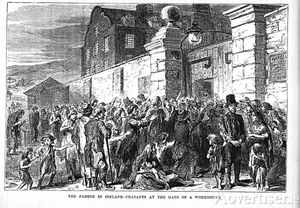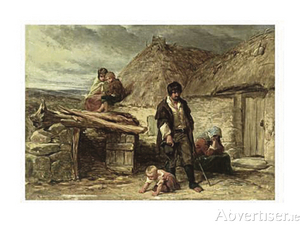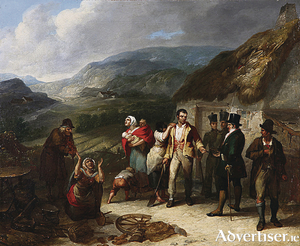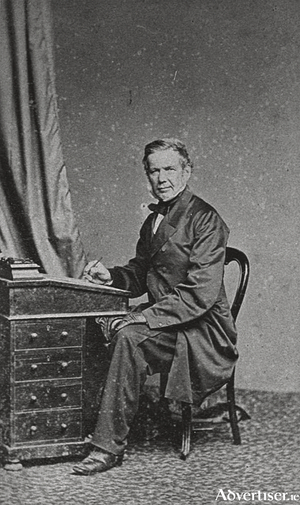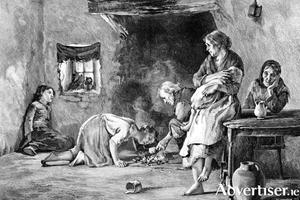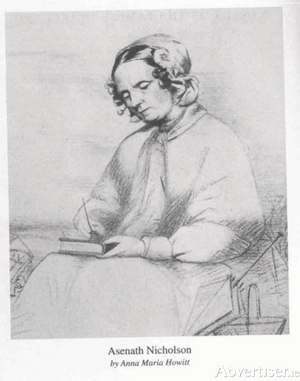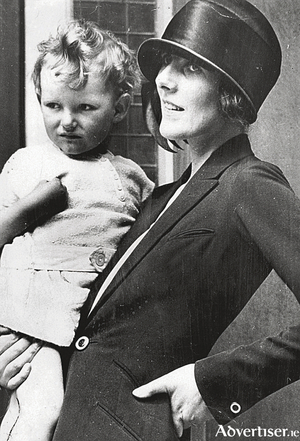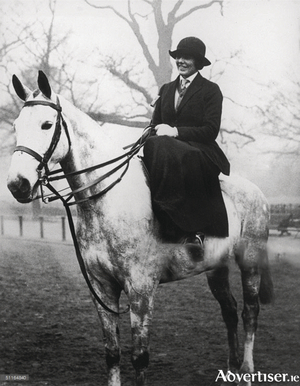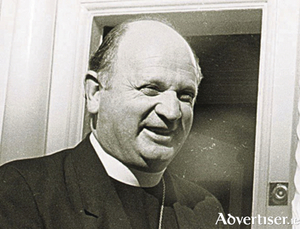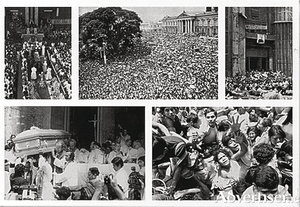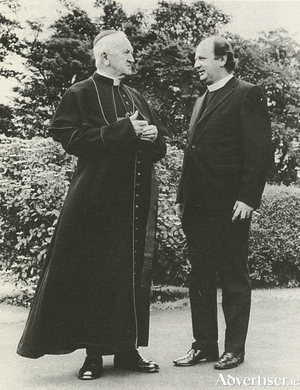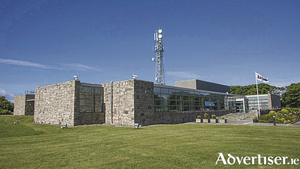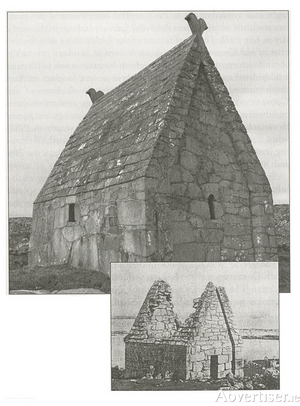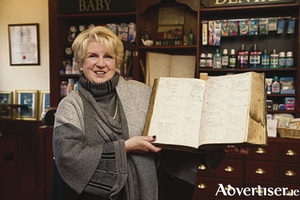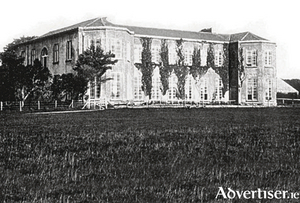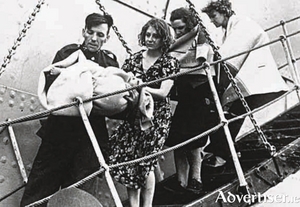Searching for the lost Mountbellew workhouse girls
Thu, Jun 29, 2017
Week III
In an imaginative and generous exercise that is reaching across the oceans, a team of genealogists and researchers have combined their talents to search for some of the missing young women sent overseas just after the Great Famine.
Girls escape from the workhouse into oblivion
Thu, Jun 22, 2017
Week II
The Mountbellew guardians wanted to clear the workhouse of their ‘permanent deadweight’ as quickly as possible. The savings to be had from reducing inmates were considerable, and there was pressure from ratepayers to reduce costs. Furthermore many of the girls were troublesome, arguementative, with nothing to do. They were a bad example to the rest of the inmates. It was agreed that it would be better for everyone if guardians availed of the assisted emigration schemes.
The behaviour of the girls was causing problems
Thu, Jun 15, 2017
Apart from overcrowding and disease, the biggest problem in many of the workhouses was the behaviour of young women. The women, who perhaps had been brought there as children, were now adolescent, many of them unruly and wild. They tended to be the most troublesome, involved in fighting and, on occasions, rioting. Their behaviour resulted from boredom. While males could be employed breaking stones, or farm work, there were not enough jobs for females, and no effort made to educate them or train them in any skill. By June 1850 in the Mountbellew workhouse, Co Galway, females made up 60 per cent of the inmate population. Three hundred and eighty two were adult; while 199 were aged between nine and 15 years.
Read more ...Feeding children during the Great Famine
Thu, Jun 08, 2017
Week III
If Aesnath Nicholson was one of a diverse group of visitors drawn to Ireland to witness, or to help with relief, as the Great Famine spread with lethal intenstity throughout rural Ireland, I am not too surprised to find a Polish count among them.
A stranger among the poor
Thu, May 25, 2017
During her first visit to Ireland while walking the road from Oranmore to Loughrea, Aesnath Nicholson, a lone witness to the growing desperation of the poor as successive years of the Great Famine took its frightening toll, stopped to rest her blistered feet. She leant against a wall and thought about the advice her friends had given her in America. They told her the trip was reckless and she would damage her health. Yet even at that moment she asked herself: Would she rather be back in her parlour in New York?
Read more ...The priest who celebrated his own funeral Mass
Thu, May 18, 2017
Week III
When the well liked Fr Thomas Campbell, parish priest of Tynagh, Co Galway, died in 1983, there was a big turn out for his funeral. Michel Déon and his wife Chantal, being French, arrived at the church on time. As no one else was there they sat in the front row.
When the well liked Fr Thomas Campbell, parish priest of Tynagh, Co Galway, died in 1983, there was a big turn out for his funeral. Michel Déon and his wife Chantal, being French, arrived at the church on time. As no one else was there they sat in the front row.
Read more ...A portrait of a lady
Thu, May 11, 2017
Some months after Lady Christobel Ampthill’s spectacular accident (her horse who refused to jump a flooding stream, and she was thrown into the river, and nearly drowned), Michel Déon and his wife Chantal, came across her sitting in her car near Kinvara.* She clearly looked distressed. There was a rumour that she had not fully recovered from her accident. She was getting forgetful.
Read more ...Riding side-saddle, and other French tales
Thu, May 04, 2017
I do not know the statistics, but I feel sure that the greatest number of our continental visitors come from France. During the summer you hear and see a lot of French people clutching maps of our small city, wandering about in groups; or lines of young students talking and gesturing happily among themselves, not paying the least attention to their guide. The French are not operatic like the Italians. They share beautiful sounding words; but the face is serious. I feel there is something of Old Europe in the French language.
Read more ...The Bishop’s blanket
Thu, Apr 27, 2017
Fr Pat Connaughton, Bishop Casey’s secretary for a while, recalled a time when he and the bishop were going to a meeting in the archbishop’s house in Thurles. “Our car broke down. No matter. We were near Thurles. We left it on the side of the road, and walked the rest of the way, the bishop’s arms swinging by his side. We were passed by Bishop Kevin McNamara, in many ways the very antithesis of Casey. McNamara looked out the window, and remarked to his driver: ‘There goes Eamonn in drama again.’
Read more ...The day Bishop Casey challenged America’s power
Thu, Apr 20, 2017
‘It was a scandal the way people waited in vain to see President Reagan and all they saw was a hand at the window,” lamented the late Cllr John F King at the first city council meeting following the visit of President and Mrs Reagan to Galway on June 2 1984.
There was a chorus of agreement around the table. Cllr Bridie O’Flaherty said that she had two daughters living in America. They had phoned her to say how ashamed they were to see the American flag burned in the streets of Dublin. “It was very unjust, very unfair, and very wrong to burn that flag,” she added irately.
Read more ...Events that must have haunted Bishop Casey
Thu, Apr 13, 2017
In May 1989 Galway watched with some bemusement, as Michael Dee entertained Daniel Ortega and members of his junta. They had successfully overthrown the dictator Anastasio Somoza, and seized control of Nicaragua, the largest country in Central America. Both men are presidents of their respective countries today. But 28 years ago while Ortega’s hand had already reached out for the il presidente crown, Michael Dee had still some way to go.
Read more ...Galway watched its new bishop with some amazement
Thu, Apr 06, 2017
On Sunday September 19 1976 the former bishop of Kerry, Eamonn Casey, succeeded to the See of Galway. He had been appointed some months beforehand, but was delayed by his long goodbye tour of Kerry. The people of Kerry were heartbroken to lose him.
Read more ...‘A New Israel for Iarchonnacht?’
Thu, Mar 30, 2017
Although many of us swallowed hard at Desmond Fennell’s cry for a ‘new Israel for Iarchonnacht’ we knew what he meant. In the 1970s the Irish language was fast slipping away, even in the Connemara Gaeltacht. Of course there were many who cherished Irish. There were Gaeilgeoirí in Dublin and elsewhere who delighted in Irish conversation. I often heard Irish spoken with ease and fluency among shoppers in Galway city.
Read more ...The Teach Furbo Incident...
Thu, Mar 23, 2017
Week II
I am not sure which came first, Desmond Fennell’s letter to The Irish Times in January 1969, or the ‘Teach Furbo incident’. But both events were triggers which fired the first shots in the re-awakening of the Irish language; and which brought some remarkable results, especially to south and west Connemara.
Irish - is it time to declare a language emergency?
Thu, Mar 16, 2017
‘Most of us don’t want to speak Irish, but we like to have Irish in our lives’, writes the provocative Desmond Fennell, in one of his concluding essays in his just published autobiography.* ‘We cherish Irish, the surveys show, as a precious part of our national heritage. We are glad there are Gaelscoileanna, a Ráidió na Gaeltachta and a TG4; that the destinations of buses are shown in Irish as well as English, and to hear that there is a magazine of news and comment in Irish on the internet. We would not like everything in Ireland to be in English only’.
Read more ...Passage of time....
Thu, Mar 09, 2017
An interesting story has emerged linking a badly burnt survivor from the SS Athenia, a Galway pharmacy, and Glasgow’s Riverside Museum.
Read more ...Merlin Park - An epilogue
Thu, Mar 02, 2017
Merlin Park House was a large late Georgian pile surrounded by trees, but built on a sufficient height that it enjoyed views of Galway Bay. It was originally built in the early 19th century by the influential Blake family, who were renowned for throwing wild parties and hunting with the hounds.
Read more ...International outcry at Athenia sinking
Thu, Feb 23, 2017
Week III
The sinking of the passenger liner SS Athenia on the evening of September 3 1939, off the Rockall Bank, prompted immediate outrage among the Allied and neutral nations. The ship, belonging to the Donaldson line, left Glasgow for Montreal, Canada, via Liverpool and Belfast on September 1. On board were more than 1,100 passengers, including women and children and 311 Americans, fleeing the inevitable war coming in Europe. One hundred and twenty eight passengers and crew were killed, 28 of whom were US citizens. Due to relatively calm seas, the survivors were picked up by passing ships, and brought to various ports including Galway, which I have mentioned recently.
The sinking of the passenger liner SS Athenia on the evening of September 3 1939, off the Rockall Bank, prompted immediate outrage among the Allied and neutral nations. The ship, belonging to the Donaldson line, left Glasgow for Montreal, Canada, via Liverpool and Belfast on September 1. On board were more than 1,100 passengers, including women and children and 311 Americans, fleeing the inevitable war coming in Europe. One hundred and twenty eight passengers and crew were killed, 28 of whom were US citizens. Due to relatively calm seas, the survivors were picked up by passing ships, and brought to various ports including Galway, which I have mentioned recently.
Read more ...‘I have lost everything except my sense of humour’
Thu, Feb 16, 2017
Week II
‘As we went alongside the Knute Nelson a tremendous cheer went up from the survivors who lined the decks’, wrote the Connacht Tribune correspondent, Seán Kenny. ‘Many of them broke down completely and wept openly.’ US Minister to Ireland, John Cudahy, was the first up the ladder to greet the survivors, and to confer with Captain James Cook of the Athenia. He was followed closely by Fr Conway and the doctors. Under the direction of the doctors, the Irish soldiers brought the stretcher cases and injured on to the tender first. Ten seriously injured were removed from the ship; among them were several elderly people, two Athenia crewmen who had been badly hurt in the explosion, and three children.
